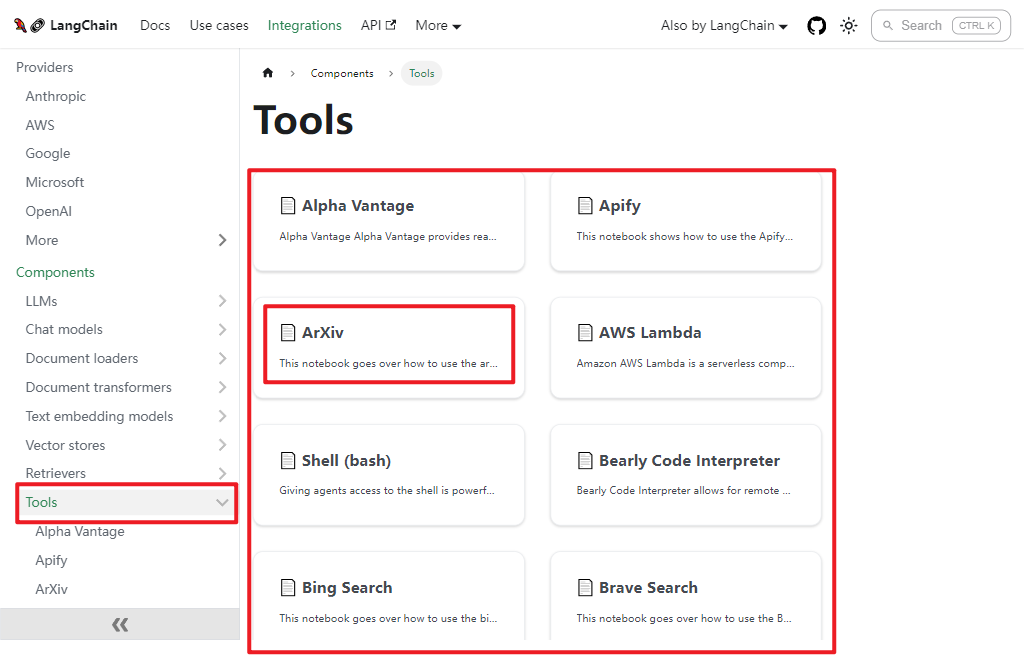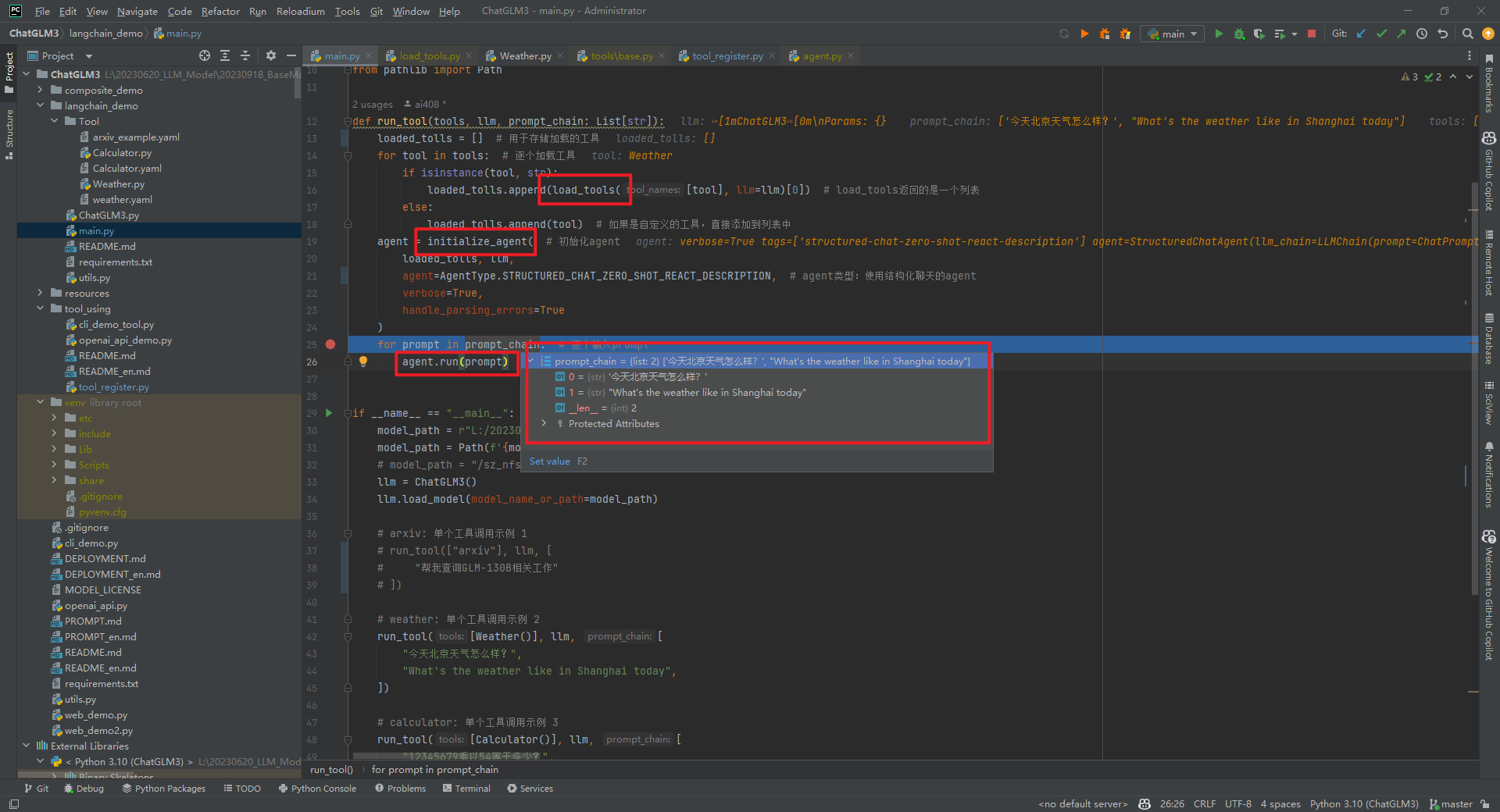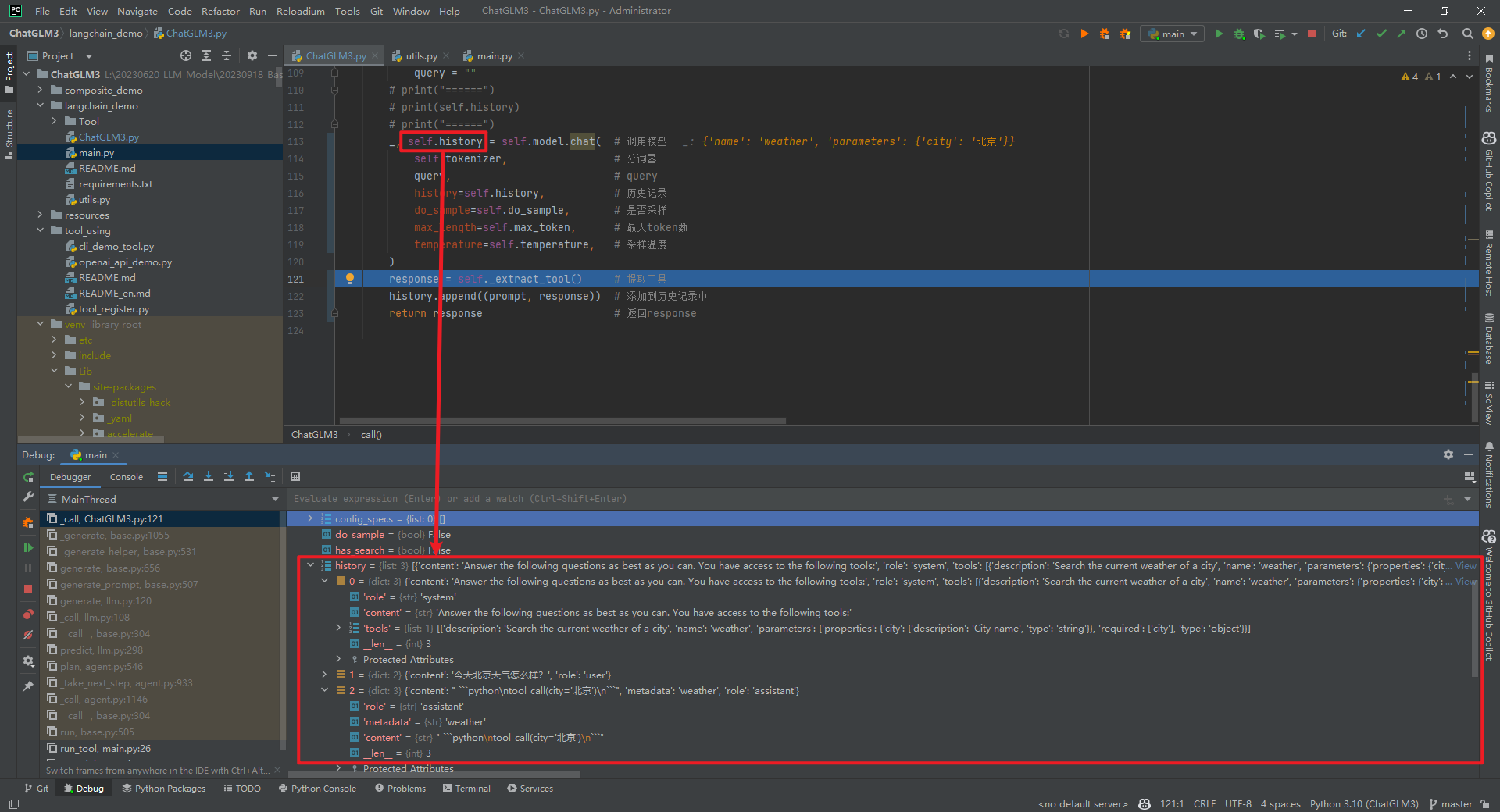Langchain-Chatchat專案:5.1-ChatGLM3-6B工具呼叫
在語意、數學、推理、程式碼、知識等不同角度的資料集上測評顯示,ChatGLM3-6B-Base 具有在10B以下的基礎模型中最強的效能。ChatGLM3-6B採用了全新設計的Prompt格式,除正常的多輪對話外。同時原生支援工具呼叫(Function Call)、程式碼執行(Code Interpreter)和Agent任務等複雜場景。本文主要通過天氣查詢例子介紹了在tool_registry.py中註冊新的工具來增強模型能力。
可以直接呼叫LangChain自帶的工具(比如,ArXiv),也可以呼叫自定義的工具。LangChain自帶的部分工具[2],如下所示:

一.自定義天氣查詢工具
1.Weather類
可以參考Tool/Weather.py以及Tool/Weather.yaml檔案,繼承BaseTool類,過載_run()方法,如下所示:
class Weather(BaseTool): # 天氣查詢工具
name = "weather"
description = "Use for searching weather at a specific location"
def __init__(self):
super().__init__()
def get_weather(self, location):
api_key = os.environ["SENIVERSE_KEY"]
url = f"https://api.seniverse.com/v3/weather/now.json?key={api_key}&location={location}&language=zh-Hans&unit=c"
response = requests.get(url)
if response.status_code == 200:
data = response.json()
weather = {
"temperature": data["results"][0]["now"]["temperature"],
"description": data["results"][0]["now"]["text"],
}
return weather
else:
raise Exception(
f"Failed to retrieve weather: {response.status_code}")
def _run(self, para: str) -> str:
return self.get_weather(para)
2.weather.yaml檔案
weather.yaml檔案內容,如下所示:
name: weather
description: Search the current weather of a city
parameters:
type: object
properties:
city:
type: string
description: City name
required:
- city
二.自定義天氣查詢工具呼叫
自定義天氣查詢工具呼叫,在main.py中匯入Weather工具。如下所示:
run_tool([Weather()], llm, [
"今天北京天氣怎麼樣?",
"What's the weather like in Shanghai today",
])
其中,run_tool()函數實現如下所示:
def run_tool(tools, llm, prompt_chain: List[str]):
loaded_tolls = [] # 用於儲存載入的工具
for tool in tools: # 逐個載入工具
if isinstance(tool, str):
loaded_tolls.append(load_tools([tool], llm=llm)[0]) # load_tools返回的是一個列表
else:
loaded_tolls.append(tool) # 如果是自定義的工具,直接新增到列表中
agent = initialize_agent( # 初始化agent
loaded_tolls, llm,
agent=AgentType.STRUCTURED_CHAT_ZERO_SHOT_REACT_DESCRIPTION, # agent型別:使用結構化聊天的agent
verbose=True,
handle_parsing_errors=True
)
for prompt in prompt_chain: # 逐個輸入prompt
agent.run(prompt)
1.load_tools()函數
根據工具名字載入相應的工具,如下所示:
def load_tools(
tool_names: List[str],
llm: Optional[BaseLanguageModel] = None,
callbacks: Callbacks = None,
**kwargs: Any,
) -> List[BaseTool]:
2.initialize_agent()函數
根據工具列表和LLM載入一個agent executor,如下所示:
def initialize_agent(
tools: Sequence[BaseTool],
llm: BaseLanguageModel,
agent: Optional[AgentType] = None,
callback_manager: Optional[BaseCallbackManager] = None,
agent_path: Optional[str] = None,
agent_kwargs: Optional[dict] = None,
*,
tags: Optional[Sequence[str]] = None,
**kwargs: Any,
) -> AgentExecutor:
其中,agent預設為AgentType.ZERO_SHOT_REACT_DESCRIPTION。本文中使用為AgentType.STRUCTURED_CHAT_ZERO_SHOT_REACT_DESCRIPTION,一種為聊天模型優化的zero-shot react agent,該agent能夠呼叫具有多個輸入的工具。
3.run()函數
執行鏈的便捷方法,這個方法與Chain.__call__之間的主要區別在於,這個方法期望將輸入直接作為位置引數或關鍵字引數傳遞,而Chain.__call__期望一個包含所有輸入的單一輸入字典。如下所示:
def run(
self,
*args: Any,
callbacks: Callbacks = None,
tags: Optional[List[str]] = None,
metadata: Optional[Dict[str, Any]] = None,
**kwargs: Any,
) -> Any:
 4.結果分析
4.結果分析
結果輸出,如下所示:
> Entering new AgentExecutor chain...
======
======
Action:
``
{"action": "weather", "action_input": "北京"}
``
Observation: {'temperature': '20', 'description': '晴'}
Thought:======
======
Action:
``
{"action": "Final Answer", "action_input": "根據查詢結果,北京今天的天氣是晴,氣溫為20℃。"}
``
> Finished chain.
> Entering new AgentExecutor chain...
======
======
Action:
``
{"action": "weather", "action_input": "Shanghai"}
``
Observation: {'temperature': '20', 'description': '晴'}
Thought:======
======
Action:
``
{"action": "Final Answer", "action_input": "根據最新的天氣資料,今天上海的天氣情況是晴朗的,氣溫為20℃。"}
``
> Finished chain.
剛開始的時候沒有找到識別實體city的地方,後面偵錯ChatGLM3/langchain_demo/ChatGLM3.py->_call()時發現了一個巨長的prompt,這不就是zero-prompt(AgentType.STRUCTURED_CHAT_ZERO_SHOT_REACT_DESCRIPTION)嗎?順便吐槽下LangChain的程式碼真的不好偵錯。


三.註冊工具增強LLM能力
1.註冊工具
可以通過在tool_registry.py中註冊新的工具來增強模型的能力。只需要使用@register_tool裝飾函數即可完成註冊。對於工具宣告,函數名稱即為工具的名稱,函數docstring即為工具的說明;對於工具的引數,使用Annotated[typ: type, description: str, required: bool]標註引數的型別、描述和是否必須。將get_weather()函數進行註冊,如下所示:
@register_tool
def get_weather( # 工具函數
city_name: Annotated[str, 'The name of the city to be queried', True],
) -> str:
"""
Get the current weather for `city_name`
"""
if not isinstance(city_name, str): # 引數型別檢查
raise TypeError("City name must be a string")
key_selection = { # 選擇的鍵
"current_condition": ["temp_C", "FeelsLikeC", "humidity", "weatherDesc", "observation_time"],
}
import requests
try:
resp = requests.get(f"https://wttr.in/{city_name}?format=j1")
resp.raise_for_status()
resp = resp.json()
ret = {k: {_v: resp[k][0][_v] for _v in v} for k, v in key_selection.items()}
except:
import traceback
ret = "Error encountered while fetching weather data!\n" + traceback.format_exc()
return str(ret)
具體工具註冊實現方式@register_tool裝飾函數,如下所示:
def register_tool(func: callable): # 註冊工具
tool_name = func.__name__ # 工具名
tool_description = inspect.getdoc(func).strip() # 工具描述
python_params = inspect.signature(func).parameters # 工具引數
tool_params = [] # 工具引數描述
for name, param in python_params.items(): # 遍歷引數
annotation = param.annotation # 引數註解
if annotation is inspect.Parameter.empty:
raise TypeError(f"Parameter `{name}` missing type annotation") # 引數缺少註解
if get_origin(annotation) != Annotated: # 引數註解不是Annotated
raise TypeError(f"Annotation type for `{name}` must be typing.Annotated") # 引數註解必須是Annotated
typ, (description, required) = annotation.__origin__, annotation.__metadata__ # 引數型別, 引數描述, 是否必須
typ: str = str(typ) if isinstance(typ, GenericAlias) else typ.__name__ # 引數型別名
if not isinstance(description, str): # 引數描述必須是字串
raise TypeError(f"Description for `{name}` must be a string")
if not isinstance(required, bool): # 是否必須必須是布林值
raise TypeError(f"Required for `{name}` must be a bool")
tool_params.append({ # 新增引數描述
"name": name,
"description": description,
"type": typ,
"required": required
})
tool_def = { # 工具定義
"name": tool_name,
"description": tool_description,
"params": tool_params
}
print("[registered tool] " + pformat(tool_def)) # 列印工具定義
_TOOL_HOOKS[tool_name] = func # 註冊工具
_TOOL_DESCRIPTIONS[tool_name] = tool_def # 新增工具定義
return func
2.呼叫工具
參考檔案ChatGLM3/tool_using/openai_api_demo.py,如下所示:
def main():
messages = [ # 對話資訊
system_info,
{
"role": "user",
"content": "幫我查詢北京的天氣怎麼樣",
}
]
response = openai.ChatCompletion.create( # 呼叫OpenAI API
model="chatglm3",
messages=messages,
temperature=0,
return_function_call=True
)
function_call = json.loads(response.choices[0].message.content) # 獲取函數呼叫資訊
logger.info(f"Function Call Response: {function_call}") # 列印函數呼叫資訊
tool_response = dispatch_tool(function_call["name"], function_call["parameters"]) # 呼叫函數
logger.info(f"Tool Call Response: {tool_response}") # 列印函數呼叫結果
messages = response.choices[0].history # 獲取歷史對話資訊
messages.append(
{
"role": "observation",
"content": tool_response, # 呼叫函數返回結果
}
)
response = openai.ChatCompletion.create( # 呼叫OpenAI API
model="chatglm3",
messages=messages,
temperature=0,
)
logger.info(response.choices[0].message.content) # 列印對話結果
參考文獻:
[1]https://github.com/THUDM/ChatGLM3/tree/main
[2]https://python.langchain.com/docs/integrations/tools